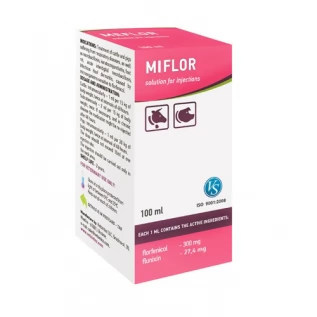Descriptoin
Oily, colorless topale-yellow liquid, opalescence is acceptable.
Composition
Each 1 ml contains the activeingredients:
Florfenicol - 300 mg;
Flunixin (as flunixinmeglumine) - 27.4 mg.
Pharmacological properties
The active ingredients of the drug are florfenicol and flunixin.
Florfenicol is active against gram-negative and gram-positive bacteriasincluding: Staphylococcusspp., Streptococcus spp., Enterobacter spp., E. сoli, Pasteurella haemolytica, Pasteurellamultocida, Pasteurella piscicida, Vibrio spp., Haemophilus somnus, Haemophilusparasuis, Fusobacterium necrophorum, Bacteroides melaninogenicus, A.pleuropneumoniae, Bordetella bronchiseptica, Salmonella spp., Klebsiella spp.,Proteus spp., Shigella spp. And others.
Florfenicol is active against most types of mycoplasma (Mycoplasmahyopneumoniae, Mycoplasma hyorhinis and others).
The mode of action of the preparation is to bind to 70S ribosomes and block protein synthesis inbacterial cells.
Flunixin - a non-narcotic, non-steroidal analgesic, which has a stronganti-inflammatory, antipyretic and antiendotoxic effect.
Flunixin acts as a reverse inhibitor of COX - the enzyme which isresponsible for the conversion of arachidonic acid into cyclic endoperoxides. Thusinhibits the synthesis of mediators of inflammation, cause fever, pain andcongestion. Flunixin also inhibits the release of thromboxane.
Flunixin shows antipyretic effect by inhibiting prostaglandin E2synthesis in the hypothalamus. Flunixin also causes antiendotoxic effect byinhibiting the formation of inflammatory mediators, thus limiting theirinvolvement in diseases which are accompanied by endotoxin states.
Indications
Treatment of cattleand pigs suffering from respiratory diseases, as well as necrobacillosis,keratoconjunctivitis, foot rot, acute interdigital necrobacillosis, InfectiousHoof dermatitis, caused by microorganisms sensitive to florfenicol.
Dosage and administration
Cattle:
Intramuscularly – 1 ml per 15 kg body weight, twice at an interval of 48 hours;
Subcutaneously – 2 ml per 15 kg of body weight,once. If necessary, and in chronic disease the drug might be re-injected after48 hours.
Pigs:
Intramuscularly– 1 ml per 20 kg body weight, twice at an interval of 48 hours.
The dose should notexceed 10 ml at one injection site. The injection should be carried out only inthe neck area.
Contraindications
Do not use in animals withsensitivity to florfenicol and flunixin.
Do not use in animals duringpregnancy and lactation.
Do not use concurrently withthiamphenicol or chloramphenicol, antibiotics of the penicillin group,cephalosporins, fluoroquinolones, as there is a possibility of toxicity.
Do not use together withsulfanilamidnymi drugs.
Do not use in animals withtheir liver or kidneys severely affected.
Precautions
Animals may only be slaughtered for humanconsumption after 46 days (for cattle when the drug is intramuscularlyadministered), 44 days (for cattle when the drug is subcutaneously injected) and 20 days (forpigs) from the last treatment.
When applying the drug inpigsit may causeredness, swelling ofperianal and soft feces,which does not affect thephysiological state of the animal and will pass with time.
Theuse of the drug in pregnant animals is allowed only in cases where thesensitivity of the pathogen to the drug is determined and the effect of theapplication exceeds the possible economic losses.
How Supplied
Neutral glass vials of 10-mL,20-mL, 50-mL and 100-mL, closed by a rubber stopper and sealed with an aluminumcover.
Storage
In a dark, dry place, at 5ºС - 25ºС.
Keep out of reach of children.
Shelf life: 2 years.
